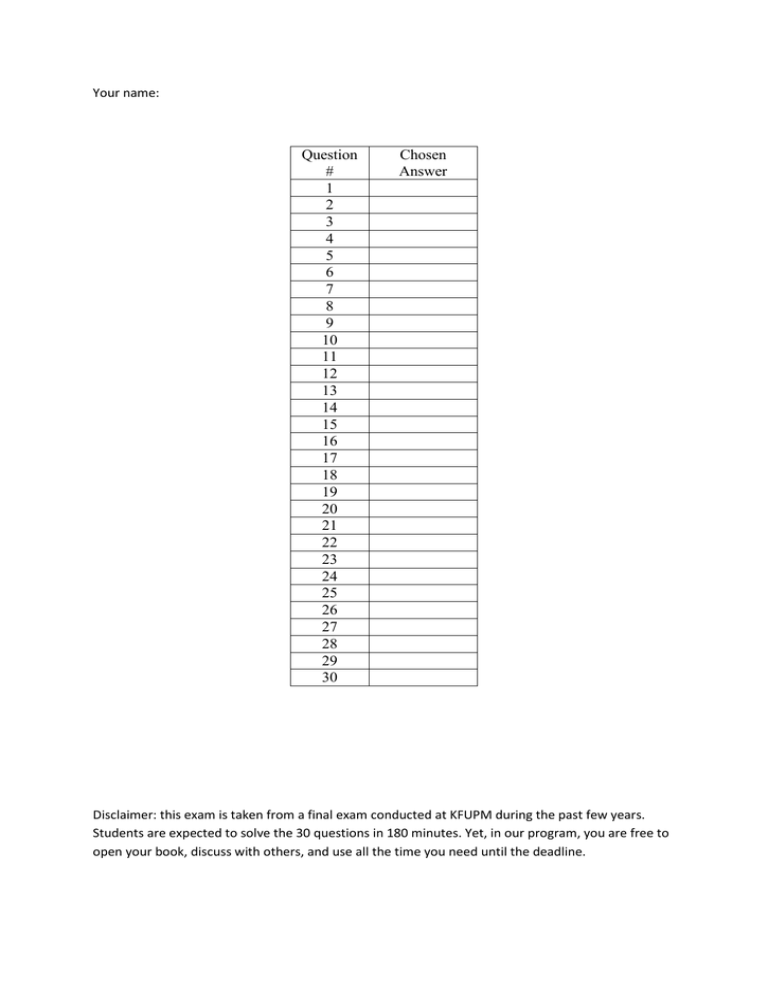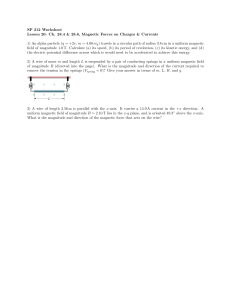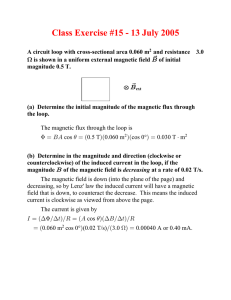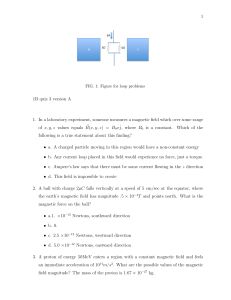Question Chosen # Answer
advertisement

Your name: Question # 1 2 3 4 5 6 7 8 9 10 11 12 13 14 15 16 17 18 19 20 21 22 23 24 25 26 27 28 29 30 Chosen Answer Disclaimer: this exam is taken from a final exam conducted at KFUPM during the past few years. Students are expected to solve the 30 questions in 180 minutes. Yet, in our program, you are free to open your book, discuss with others, and use all the time you need until the deadline. Q1. A standing wave on a string is described by: y (x,t) = 0.040 (sin 5 x) (cos 40 t), where x and y are in meters and t is in seconds. If the length of the string is 1.0 m, what is the harmonic number of the wave? A) 1 B) 2 C) 3 D) 4 E) 5 Q2. The sound levels of two sound sources differ by 8.2 dB. What is the ratio of the larger to the smaller intensity? A) 6.6 B) 1.6 C) 0.15 D) 0.63 E) 0.91 Q3. How much water remains unfrozen after 50 kJ is transferred as heat from 250 g of liquid water initially at 0.0 oC? A) 100 g B) 150 g C) 50 g D) 200 g E) 0 Q4. In the p-V diagram of FIGURE 1, the gas does 5 J of work when taken along isotherm ab, and 4 J of work when taken along the adiabat bc. What is the change in the internal energy of the gas when it is taken along the straight path from a to c? Fig# A) – 4 J B) – 5 J C) + 9 J D) – 1 J E) + 1 J Q5. A sample of an ideal gas expands from state A to state B. Let ΔSI denote the change in entropy of the gas for an irreversible expansion. Let ΔSR denote the change in entropy of the gas for a reversible expansion. Then: A) ΔSI = ΔSR B) ΔSI > ΔSR C) ΔSI < ΔSR D) ΔSI < 0 E) ΔSR < 0 Q6. A point charge Q1 = + 2.00 C is placed on the x-axis at x = +2.00 cm. Another point charge Q2 is placed on the x-axis at x = +5.00 cm. A third point charge Q3 is placed at the origin. If the net electric force on Q3 is zero, what is the charge Q2? A) – 12.5 C B) + 12.5 C C) – 5.00 C D) + 5.00 C E) – 2.00 C Q7. Three charged particles are fixed at the corners of a square, as shown in FIGURE 2. Consider point P, which is the top right corner of the square. Which of the indicated arrows represents the direction of the net electric field at point P? Fig# A) V B) I C) II D) III E) IV Q8. A cylindrical Gaussian surface has a radius of 0.20 m. The axis of the cylinder is along the x axis, with one end at x = 0 and the other end at x = 2.0 m, as shown in FIGURE 12. The cylinder lies in a region ˆ where the electric field is E xi (N/C), where x is in meters. What is the charge enclosed inside the cylinder? Fig# A) + 2.2 pC B) – 4.4 pC C) + 4.4 pC D) – 2.2 pC E) zero Q9. A uniform electric field of magnitude 350 V/m is directed in the negative y direction. The coordinates of point A are (–0.20, –0.30) m, and those of point B are (0.40, 0.50) m. Calculate the electric potential difference VB – VA. A) - 280 V B) + 280 V C) + 210 V D) – 210 V E) – 350 V Q10. Consider the combination of capacitors shown in FIGURE 3, with C1 = 2.0 F, C2 = 3.0 F, and C3 = 2.0 F. What is the energy stored by the combination if the potential difference between points A and B is 60 V? Fig# A) 2.0 mJ B) 7.9 mJ C) 22 mJ D) 0.83 mJ E) 8.2 mJ Q11. A cylindrical conducting wire has radius ri and length Li. Its dimensions are changed to rf and Lf. Which of the following changes results in the least resistance? A) rf = 2ri and Lf = 2Li B) rf = 2ri and Lf = Li/2 C) rf = 2ri and Lf = Li D) rf = ri/2 and Lf = Li/2 E) rf = ri/2 and Lf = 2Li Q12. A light bulb utilizes a tungsten filament. The filament has a resistance of 3.40 at 20.0 oC. The bulb is connected to a 24.0-V battery. When the bulb reaches its final operating temperature, the filament dissipates a power of 16.0 W. What is the operating temperature of the filament? The temperature coefficient of resistivity of tungsten is 4.50 x 10-3 K-1. Assume that the dimensions of the filament do not change. A) 2.15 × 103 oC B) 1.44 × 103 oC C) 2.37 × 103 oC D) 1.90 × 103 oC E) 2.26 × 103 oC Q13. Four resistors are connected to an ideal battery, as shown in FIGURE 13. The current supplied by the battery is Io. If R3 , the current supplied by the battery is Fig# A) 3I o 4 B) 4Io C) Io 4 D) 4I o 3 E) 15 I o 11 Q14. Each of the resistors in FIGURE 4 has a resistance of 50.0 . The equivalent resistance between points A and B is Fig# A) 104 B) 210 C) 171 D) 121 E) 111 Q15. Five resistors are connected as shown in FIGURE 5. The potential difference between points A and B is 25.0 V. What is current through the 1.80- resistor? Fig# A) 2.76 A B) 3.34 A C) 1.67 A D) 0.577 A E) 2.09 A Q16. In the circuit shown in FIGURE 6, the current I = 0.36 A. What is the potential difference VA – VB? Fig# A) + 2.9 V B) + 1.1 V C) – 1.1 V D) – 2.9 V E) – 4.7 V Q17. In an RC circuit, a 10-µF capacitor is discharged through a resistor R. If the potential difference across the capacitor plates drops to 37 % of its initial value in 2.0 s, then the resistance of R is A) 2.0 × 105 B) 1.0 × 105 C) 5.0 × 105 D) 1.0 × 106 E) 2.5 × 106 Q18. What is the magnitude of the magnetic force on a charged particle (Q = + 5.0 C) moving with a speed of 80 km/s in the positive x direction in a region containing a uniform magnetic field B with components Bx = 5.0 T, By = 4.0 T, and Bz = 3.0 T? A) 2.0 N B) 1.6 N C) 1.2 N D) 2.8 N E) 0.40 N Q19. An ion with a charge of +3.3 10−19 C is moving in a region where a uniform electric field of magnitude 5.0 104. V/m is perpendicular to a uniform magnetic field of magnitude 0.80 T. If the ion’s acceleration is zero then its speed must be (ignore gravity) A) 3.1 105 m/s B) 1.3 104 m/s C) 4.0 105 m/s D) 3.6 105 m/s E) 6.3 104 m/s Q20. A straight wire, of length 1.0 m, carries a current of 1.0 A in the positive z direction in a region where ˆ (T). The magnitude of the magnetic force on the wire is the magnetic field is B 3.0ˆi 2.0ˆj 1.0k A) 1.0 N B) 5.0 N C) 4.2 N D) 3.0 N E) 3.6 N Q21. Figure 7 shows the path of an electron that passes through two regions containing uniform magnetic fields B1 and B2. Its path in each region is a half circle. Which of the following statements is CORRECT? A) The electron spends the same time in both fields. B) B1 has a smaller magnitude. C) The magnitudes of the two fields are equal. D) The two fields point in the same direction. E) B1 has a larger magnitude. Q22. A single circular loop of radius 1.00 m carries a current of 10.0 mA. It is placed in a uniform magnetic field of magnitude 0.500 T that is directed parallel to the plane of the loop, as shown in FIGURE 8. What is the magnitude of the torque exerted on the loop by the magnetic field? A) Zero B) 3.14 × 10–2 N.m C) 6.28 × 10–2 N.m D) 9.28 × 10–2 N.m E) 1.57 × 10–2 N.m Q23. In FIGURE 9, two infinitely long wires carry currents i. Each follows a 90o arc on the circumference of the same circle of radius R. What is the magnitude of the net magnetic field at the center of the circle (point C)? Fig# oi oi R 16 R A) B) oi R C) oi 4 R D) oi i o 2R 16 R E) oi 2 R Q24. FIGURE 10 shows two long, thin wires, parallel to the z axis, carrying currents in the positive z direction. The 50-A wire is in the x-z plane and is 5 m from the z axis. The 40-A wire is in the y-z plane and is 4 m from the z axis. What is the net magnetic field at the origin O due to the two wires? Fig# A) (2 î – 2 ĵ ) T B) (2 î + 2 ĵ ) T C) (2 î + 3 ĵ ) T D) (2 î – 3 ĵ ) T E) (3 î + 2 ĵ ) T Q25. FIGURE 11 shows a cross section of three parallel wires each carrying a current of 5.0 A out of the paper. If the distance d = 6.0 mm, what is the magnitude of the net magnetic force on a 2.0-m length of wire 1? Fig# A) 2.9 mN B) 3.3 mN C) 2.1 mN D) 3.9 mN E) 1.7 mN Q26. A long, solid, cylindrical wire carries a uniformly distributed current. If the radius of the wire is 3.5 mm, and the magnitude of the current density is 1.5 A/cm2, what is the magnitude of the magnetic field at a distance of 2.5 mm from the axis of the wire? A) 2.4 ×10-5 T B) 3.3 ×10-5 T C) 1.3 ×10-5 T D) 6.9 ×10-5 T E) zero Q27. A solenoid with N turns carries a current of 2.000 A, and has a length of 34.00 cm. If the magnitude of the magnetic field generated at the center of the solenoid is 9.000 mT, what is the value of N? A) 1218 B) 1591 C) 2318 D) 3183 E) 2078 Q28. A conducting loop is held in a uniform magnetic field, with the plane of the loop perpendicular to the field lines. Which of the following will NOT cause a current to be induced in the loop? A) Keeping the orientation of the loop fixed and moving it within the field. B) Shrinking the loop. C) Changing the shape of the loop. D) Rotating the loop about an axis perpendicular to the field lines. E) Pulling the loop out of the field. Q29. A 50-turrn coil is positioned in a magnetic field so that the normal to the plane of the coil makes an angle of 60o with the direction of the field. When the magnetic field is increased uniformly from 200 T to 600 T in 0.40 s, an emf of magnitude 80 mV is induced in the coil. What is the cross sectional area of the coil? A) 3.2 m2 B) 1.6 m2 C) 4.4 m2 D) 2.5 m2 E) 2.1 m2 Q30. A conducting bar of length L moves to the right on two frictionless rails with constant velocity v, as shown in FIGURE 14. A uniform magnetic field directed into the page has a magnitude of 0.30 T. Assume R = 9.0 , L = 0.35 m, and v = 2.0 m/s. What is the current induced in the resistor? Fig# A) 0.023 A, counterclockwise B) 0.023 A, clockwise C) 0.21 A, clockwise D) 0.21 A, counterclockwise E) 0.047 A, clockwise






